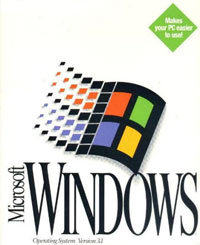

Microsoft Windows 3.1, released in April 1992, provided significant improvements to Windows 3.0. In its first two months on the market, it sold over three million copies, including upgrades from Windows 3.0. The following are the major changes from Windows 3.0:
Note: Windows 3.x is generally considered to be obsolete. Newer versions of Windows (Windows 95, 98, and Millennium Edition (Me), and Windows NT and 2000) offer additional features such as preemptive multitasking of Windows applications and a more friendly user interface.
Microsoft Windows 3.x (Windows 3.0, Windows 3.1, and Windows for Workgroups 3.11) runs on IBM compatible computers with 80x86 processors. Windows provides a Graphical User Interface (GUI) that uses the DOS file system to read and write files. Windows uses a mouse-driven point, click, and drag method to enable functions such as copying and deleting files, running programs, and interacting with Microsoft Windows applications programs.
Windows 3.1 and Windows for Workgroups 3.11 can run on IBM PC compatible computers that use the Intel 80286, 80386, 80486, Pentium, and Pentium Pro microprocessors and their variants. To run efficiently, a 386SX with 4 megabytes (MB) of RAM, a 60MB or larger hard drive, and VGA video are recommended. A fast video card (e.g., Tseng ET4000-based) will improve performance.
Windows uses a system known as cooperative multitasking to run multiple applications at once. This means that each application is responsible for giving up control of the CPU to the next program. When running in Enhanced mode, Windows is capable of running DOS applications using preemptive multitasking. This means that Windows actively assigns slices of time to the running DOS applications. In Standard mode, DOS applications are task-switched, which means they stop running when not in the foreground. Moreover, in Standard mode DOS applications can be run only full-screen and not in a Window.
Note: You must have a 386 or higher to use Enhanced mode. On a 286, Windows will run only in Standard mode.
When running Windows, you can share information between Windows and DOS applications through cut and paste, and also via dynamic links.